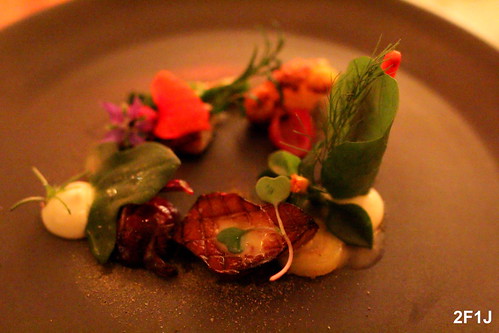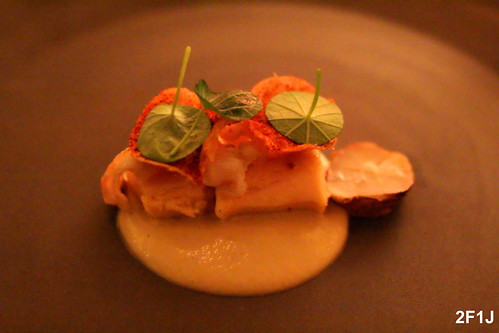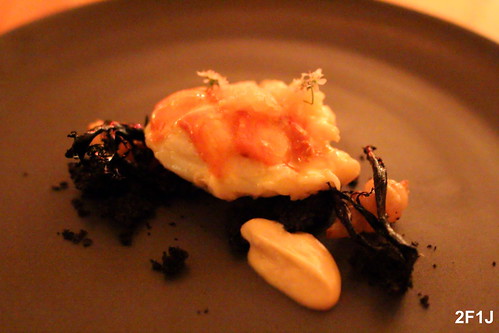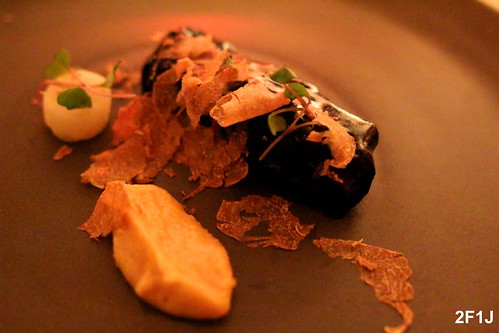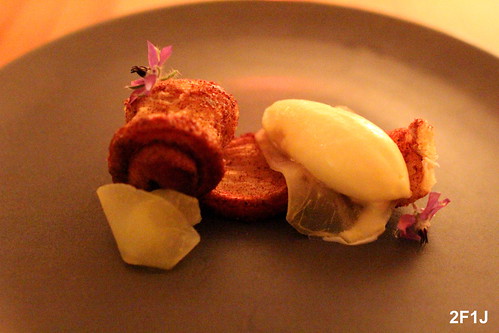The first
look when deciding on the next restaurant to visit is always for the online
menu to get an idea about the cooking style and creativity of the chef and how
it overlaps with our preferences. But the second look often immediately follows
to the personal background page of the chef. It is always very interesting to
read the vita of a chef and the different restaurants and chefs he worked for
during his career. Having worked for well-known chefs or in prestigious
restaurants obviously doesn’t guarantee that a chef will run a good restaurant
himself but at the same time it is important to have experienced and
successfully worked under high-pressure environments to fully comprehend the
restaurant business. And so it is fascinating to put together “family trees” of
well-known chefs like Thomas Keller, Charlie Trotter or Daniel Boulud to
realize their far reaching impact on the dining scene in pretty much every part
of the US and even beyond. But the impact of established chefs is not only
apparent on the national level but can be quite strong on a local level which
was nicely illustrated recently in an article about the influences of just two
chefs, Daniel Patterson of Coi and David Kinch of Manresa, on the dining scene
in San Francisco. Both chefs have trained and mentored many chefs over the
years in their kitchens that their influence on the culinary landscape in San
Francisco is undeniable through restaurants like Outerland, Commis or Rich
Table but goes even to national acclaimed ice cream shops like Humphry
Slocombe. The impact is perhaps best summed up by Chef Evan Rich with “(Kinch and Patterson) don't only teach you to cook. They
teach you how to think about food”. And it illustrates that one of the
backbones of a great culinary city are strong, visionary chefs who provide environments
for aspiring chefs and reasons for them to stay in that city.
San
Diego might not yet have the depth as a culinary city as San Francisco which
can also be explained by the missing opportunities for young chefs to grow and
get mentored by such established chefs but over the last few years several
chefs, like Trey Foshee, Jeff Jackson, Matt Gordon and Paul McCabe, and their
restaurants have started to fill out this role. We recently had the chance to
experience two former chefs, Zach Hunter and Steven Molina, who had worked
under McCabe at a pop-up dinner at Delicias. Steven Molina has since then moved
to Sea & Smoke to run the day-to-day operations of the restaurant but we
also met Chef Bautista again at that dinner whom we first encountered as sous
chef at a tasting menu at Kitchen 1540. And it reminded us that it was more
than time to set up another tasting menu at Kitchen 1540 where he was now
running the show as Chef de Cuisine. Chef Bautista finished his culinary
education at the Art Institute in San Diego in 2005 before he started working
at Roy’s where he moved up the ranks to sous chef. He then moved over to
Kitchen 1540 where he started working under Paul McCabe, worked briefly at
Michael Voltaggio’s Ink in LA, before returning to Kitchen 1540 as Chef de
Cuisine. Interestingly, when we finally
made the reservation with Chef Bautista we pretty much found out at the same
day that he was planning to start working as Chef de Cuisine at Georges Modern
around the same time. Even though we briefly considered cancelling the
reservation since it would be on one of his last days at Kitchen 1540 we also
felt that it might be a good chance to experience his own cooking before he
would work together with Trey Foshee, and it would be interesting to see how
his cooking style will be influenced in the future. (The restaurant gave us a
very nice but also very dark place and so the pictures are quite grainy)
1st
Course: Hamachi, fermented plum, soy, cucumber, daikon
Raw
fish is often seen as a start to a tasting menu since the delicate fish acts as
a welcoming canvas for a wide variety of flavors to awaken the palate. Here we
had a nicely done version with hamachi which was lightly torched to give it a
unique flavor that held up against the soy yuzu sauce and the fermented plum. The
daikon and cucumber added some textural contrast. Overall a very good start to
the tasting menu especially with the sake pairing and its floral undertones.
2nd
Course: Ocean trout, geoduck, aged parsnip, sorrel, wild trout roe
Wood
sorrel gave the broth its deep green color and with its tangy, citrusy flavor
paired well with the ocean trout. The crispy skin and a piece of geoduck added
some crunch whereas the trout roe was integral to the dish with the small
bursts of brininess.
3rd
Course: Vegetables, caper, lemon, brown butter
The
bounty of outstanding produce in San Diego is often depicted with a salad
course but Chef Bautista took a different path by showcasing it through some
outstanding lightly grilled/seared vegetables from Chino Farms ranging from
cauliflower, aubergines to turnips. This course was really about the natural
flavors of these vegetables only accentuated by a light lemony sauce. One of
the highlights of the tasting menu, raising the question why not more chefs in
San Diego use these flavors as centerpieces of dishes instead of focusing on
meat.
4th
Course: Cuttlefish, parmesan, dashi, basil
This
course reminded us most on influences from Ink in LA – cuttlefish cut into thin
pieces and pressure cooked so that it resembles visually and texturally pasta
is combined with uni and abalone on one side and a parmesan and dashi sauce on
the other side to give a Japanese inspired version of Spaghetti Carbonara. A
really well thought out course which combines creativity with flawless
execution and you would wish to have a really large bowl.
5th
Course: Hamachi belly, Chino turnips, nettle chimichurri
It
was interesting to see the different approaches between this course and the
previous one – the cuttlefish course showcased many different ingredients,
flavors and complexity whereas this course was all about simplicity and clean
flavors. Succulent hamachi belly and slightly sweet turnips complement each
other without blending the flavors. Both are wood roasted to accentuate their
roles and the nettle chimichurri connects both with its herbaceous taste.
6th
Course: Geoduck belly, razor clam, sunchoke, BBQ, yuzu
Tender
geoduck belly stood up surprisingly well against the different variations of
sunchoke, like sauce and chips, with its nutty flavor. The restrained use of
yuzu helped to bring the plate alive. The sunchoke chips and razor clam added
some nice texture.
7th
Course: Local spiny lobster, fermented onion, crosnes, black trumpet
This
might have been actually the first time that we had black trumpet mushrooms and
it is easy to understand why they are so thought after with their meaty
consistency and fruity and earthy flavor with reminiscence of black truffles. The
butter poached lobster and the fermented onion sauce with its slightly sour,
funky undertones were unexpected companions to the mushrooms but worked
remarkable well.
8th
Course: Pork short ribs, alba white truffles, potato polenta, kohlrabi
Beef
short ribs might be one of the most overused ingredients on any menu currently
and so it was a nice change to see pork short ribs especially with such an
interesting mole-like glaze. The white truffles were an unexpected pairing but
worked remarkably well as they stood up against the mole without overpowering
the dish. The potato polenta acted as the base of the dish whereas the pickled
kohlrabi, a vegetable which should be used more often by chefs, brightened up
the dish with some acidity and muted sweetness. Another highlight of the night
for which we wished for a much larger portion.
9th
Course: Lamb, ash, parley, chestnut, oats
Very
tender sous vide lamb is coated in ash which gives it a slightly bitter
undertone, but what really sets this dish apart is the combination of three
different sauces/puree – parsley puree, chestnut puree and fermented strawberry
sauce. Each of the three sauces has a very different, distinct flavor which
pairs well with the lamb and it’s interesting to try out various combinations
of them with each bite. And as in many of his dishes Chef Bautista adds some
textural component, here some oats, to avoid a too uniform overall consistency.
10th
Course: Cinnamon bun, bay leaf ice cream
Kitchen
1540 doesn’t have a regular pastry chef and so Chef Bautista is also
responsible for the sweet part of the tasting menu. We started with a wonderful
light and airy “unwrapped” cinnamon bun which was accompanied by bay leaf ice
cream. Bay leaf is one of these spices you often add to your dishes and it
doesn’t have a very prominent flavor but it adds often an important base to
many dishes. Here bay leafs took the center stage and the ice cream showed some
floral notes with hints of nutmeg and some surprising sweetness. The shaved
apple pieces completed this great dessert with some welcomed tanginess.
11th
Course: Root beer, persimmon, maple
We
normally don’t like root beer a lot and so we were a bit skeptical about the
last course but actually the root beer foam had the typical herbal notes which
often remind us on some medicine and toothpaste but paired well with the cake
and the maple ice cream and was a good end to an outstanding tasting menu.
When
we were setting up the tasting menu we were initially a little bit skeptical as
it was on one of the last days of Chef Bautista at Kitchen 1540 and so it was
hard to judge how much he would be willing to put a lot of efforts in this
tasting menu. But at the same time we also felt that it was a last chance to
experience his cooking (and potentially creative cooking in general) at Kitchen
1540. Once we started the tasting menu it turned out to be one of the best we
had experienced in San Diego. This was one of these rare occasions where
everything turned out to be a perfect night – great food, good pairings,
relaxed yet professional service. Often even at the most well known restaurants
or chefs some small annoyance happen, e.g. disappointing courses or rushed
service but here we just sat down, had a great time and were surprised how fast
more than four hours were flying by. Most importantly the food was on a very
high level with many well thought out courses which often showed bold yet
refined and complex flavors, perhaps best characterized by two of the
highlights - the cuttlefish and the pork course. And so it is not really
surprising that Chef Bautista decided to take the next career step by moving to
Georges as Chef de Cuisine as he seems to be ambitious enough not to stay in
this comfortable but not really challenging position at Kitchen1540. And since
his cooking is already on a very high level the only logical step as he
mentioned in a discussion was only to work under Trey Foshee or move somewhere
else. It will be interesting to see where his successor, Chef Brandon Fortune,
formerly of Amaya and Aquamoree, will push Kitchen1540 – continue as bastion of
fine dining or converting it to a “hotel restaurant”. The cooking style of Chef
Bautista shows influences from chefs he worked with and tends to be complex and
perhaps sometimes even a bit overthought whereas Chef Foshee has a focused
style often aiming at the elemental, pure flavor of the ingredients. Having
both work together at Georges will be interesting especially for TBL3 to see
how much they will influence each other and especially if Chef Bautista’s style
will change over time. We are looking to meet him again at our next TBL3
experience !
1540 Camino Del Mar
Del Mar, CA 92014
(858) 793-6460


